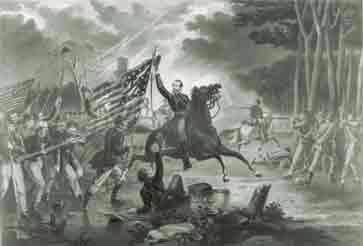As the Union troops retreated from their defeat at the Battle of Second Manassas to Centreville, General Robert E. Lee ordered his men to block the left flank. General Thomas “Stonewall” Jackson and his men marched from Manassas and Centreville to prevent General Pope from retreating any further than Fairfax . After hearing of Jackson ’s intentions, Pope order Brigadier General Isaac Stevens and his division to intercept Jackson . On September 1, 1862 , Jackson met Steven at Ox Hill, near the Little River Turnpike and Ox Hill, and they positioned for battle. Steven’s men were ambushed in an open field by Jackson ’s men in the woods. As the afternoon wore on, Steven’s attack slowed. He rallied his troops, took up the colors, and charged into the field himself. As he ran, he was swiftly killed by sharpshooters.
As Steven’s troops were falling back, they were reinforced by Major General Philip Kearny and five regiments. While rallying the men and organizing an attack, Kearny rode to the front lines to establish where and who their opponents were. After breaking through some trees into a clearing, he too was instantly killed by Georgia sharpshooters. The fighting continued for another hour or so, until both sides began to fall back. In the morning, Maj. Gen. Kearny’s body was delivered to Union forces, by order of Gen. Lee.
General Pope ordered a general retreat to Alexandria and Washington . Shortly after this engagement, Maj. Gen. George B. McClellan became the commander of the forces near Washington , and General Robert E. Lee began his campaigns of South Mountain and Antietam.1
We have had a terrific battle again to-day. The enemy, largely reinforced, assaulted our position early to-day. We held our ground firmly until six o'clock P.M., when the enemy, massing very heavy forces on our left, forced back that wing about half a mile. At dark we held that position. Under all the circumstances, both horses and men having been two days without food, and the enemy greatly outnumbering us, I thought it best to move back to this place at dark. The movement has been made in perfect order and without loss The troops are in good heart and marched off the field without the least hurry or confusion. Their conduct was very fine.
Gen. Pope in a dispatch to Gen. Halleck, September 18622
The land used for the battle belonged to the Reid family. Shortly after the War, Mary Reid Thrift and Lt. John N. Ballard were married. She had inherited the land from her grandfather, and he was a former Confederate cavalryman. On July 7, 1915, John and Mary deeded about .115 acres of their farm for the purposes of creating a memorial to the Battle of Ox Hill. It is due to their foresight and generosity that there is a park and memorial in place today.3
Today, Chantilly, and the area of Ox Hill are thriving residential and commercial centers. Shopping plazas, business offices, and apartments are less than blocks from the Ox Hill battlefield park. There are two historical signs, and a placard showing troop movements, but the total land area is not very large. The trees are not dense, and apartments can be seen through them. There is a small walkway so visitors can enter the park, but it is not long. Chantilly and Fairfax are booming areas, with a lot of industry and housing, with several major highways crisscrossing it. Despite all the growth and sprawl, it is easy to see that many of the modern roads follow similar paths to the roads walked daily by Confederate and Union Troops.







